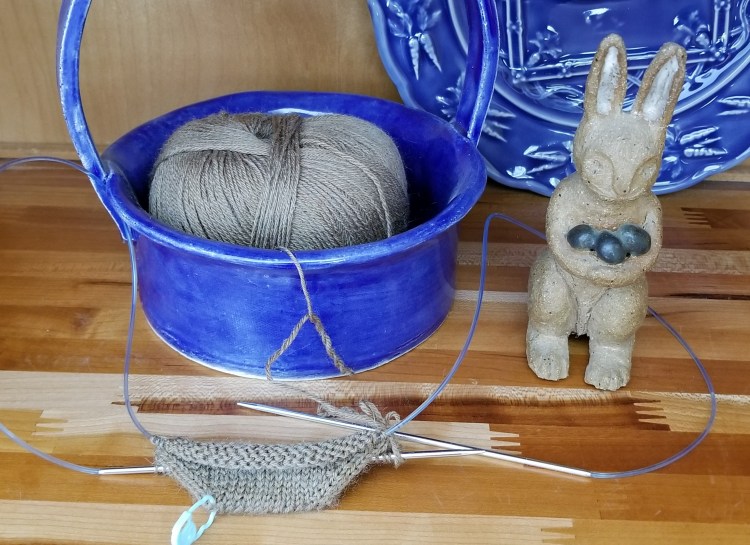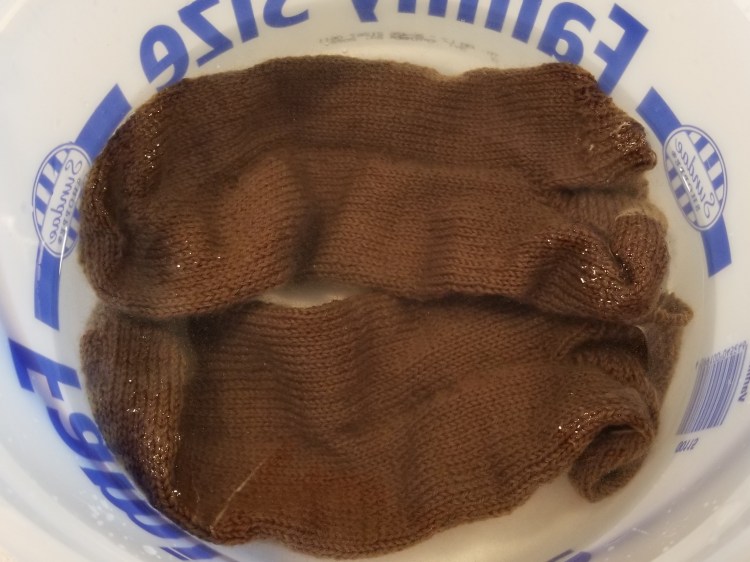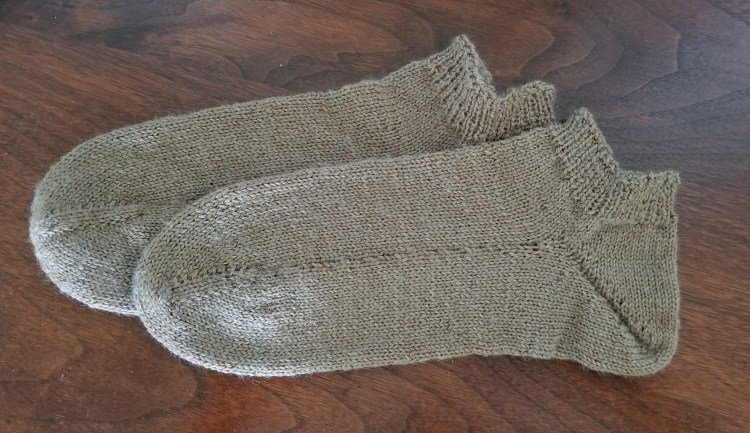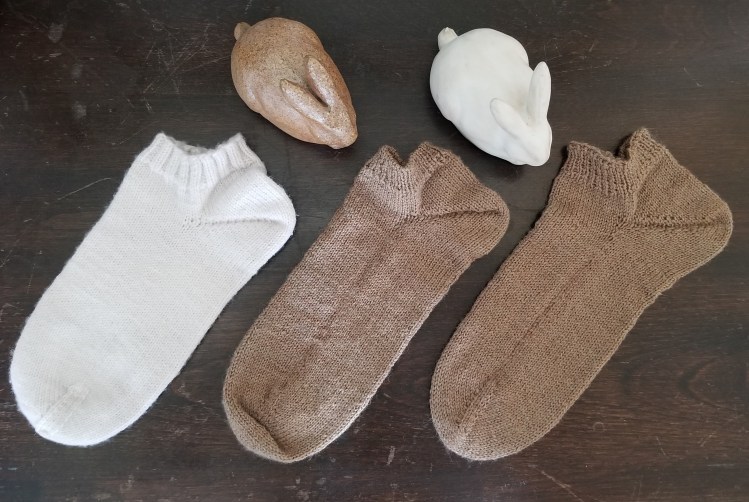I am writing about socks again which is not as interesting as my last post about helping my mom with her memoir. I understand if you want to stop reading here!
After completing the cable pattern socks over the winter that took two months to finish I wanted to use thicker yarn for my next sock project so they would knit up faster. After looking over my yarn on hand, I decided to go with some MillaMia Naturally Soft Sock 75% Wool / 25% Polymide yarn which turns out to be thinner rather than thicker. However I really liked the color and feel of it, and they look nice with both my pairs of my sneaker type shoes. This time I used a basic pattern instead of the complicated cable pattern, with a short cuff which does not take as long to make.
Polyamide, also known as nylon, is a petroleum product. It is commonly used in sock yarn to add strength, durability and elasticity. Ideally we should be using less petroleum based products, but there are always multiple factors to consider. If your socks wear out faster because they do not have nylon and you have to make or buy another pair, is that better?
Nylon, which is a type of plastic, was invented in 1935. The first successful use for nylon was in place of silk for stockings, and then after that for military uses during WWII. It is not biodegradable and sheds microplastics into the water. Other synthetic fibers made from petroleum with the same issue include polyester, acrylic, rayon, and microfiber. I read recently that microplastics have now been found in people’s blood. That is scary. I wonder what other things we are doing and manufacturing today that in the future we will realize are having impacts on the environment that we did not foresee.

I started out trying to do turkish cast on for 2 socks at a time on magic loop needles size one. The stitches were slipping all over the place and falling off the needle. Plan B was to knit the toe for the first sock and put it a holder while I knit the other toe.
After the toes were completed with both of them back on the needles for two at a time magic loop knitting, I knit a couple of inches of foot. I ripped it back and started over a couple of times before I was satisfied that the number of stitches around was right. I would rather start over and get it right than complete the project and not be happy with it.
When it was time for the heel, I considered a method of “afterthought” heel that has extra rows in the corner where the heel meets the leg. Afterthought heel is a technique where you knit past the place where the heel will be, and then later go back and knit the heel. I decided against it since an afterthought heel requires two more ends to be woven in. Instead I knitted the Fish Lips Kiss heel one at a time while the other sock was held on double pointed needles. Both the afterthought heel and the Fish Lips Kiss heel come out a little tighter around the ankle than a traditional flap heel based on the geometry of the pattern. When I got to the end of the heel, I added another stitch in the corners to add a little width. Following is a photo of both socks, with the heel completed on one sock.

I am always coming across new ideas and variations for improving the fit and construction of socks. I like to browse on Pinterest, so once it knows you are looking at sock ideas, it sends you more and more. Now I also get lots of ideas on Pinterest for recipes with rhubarb haha. I found a pattern specifically for sneaker socks that makes an adjustment to a short row heel of adding some extra rows so that the completed sock will not slip down into your shoe in the back. That was happening with the first pair of sneaker socks I made, so I decided to try it. This pattern also suggested using knit 1 purl 1 for the ribbing instead of knit 2 purl 2, as well as using something called “Italian bind off” that I had not heard of.
Following is a photo of one of the socks after I finished knitting. Somehow I ended up with a big hole in only one out of four heel corners. I was able to patch that up with a scrap of yarn.

It is hard to avoid having a funny uneven column where the two halves of the sock meet when knitting with magic loop. Because the stitches are all connected by one continuous piece of yarn, it will eventually even itself out with wear and washing. I put the just completed pair of socks into an empty ice cream tub (ice cream is a staple at our house so we have a bunch of those that I use for various purposes) with some wool soap to get the process started.

All in all I was happy with how this pair of socks came out. The Italian Bind Off looked nice and neat, but was a bit tight. Even with the extra stitch I added in each corner of the sock they could have more room in the heel diagonal, but they work.


I wanted to make another pair out of the same yarn to try a few variations in different parts of the pattern, but I had to figure out if I had enough yarn left. I had started with two 50 gram balls of yarn, one for each sock. When the socks were complete I weighed them on my kitchen scale. Subtracting the weight of the socks (39 grams) from the original weight of the yarn (100 grams) told me that the remaining yarn (61 grams) was enough to make another pair of sneaker socks. It is fascinating to me that the weight of the yarn used for a project is exactly equal to the weight of the completed project. That works when spinning wool into yarn too, except that when spinning bits of the fiber get removed in the process, so the final product might be a little less that what you started with.
I knit another pair of sneaker socks using the same pattern and yarn but with a few adjustments. First I used yarnover increases when making the toe instead of knit in the front and back. Normally yarnovers are used to make an increase, and then when you knit it on the next row it makes a hole which can be a design element. In this case I knit through the back loop so there is not a hole. I made a couple of increases in the foot just before getting to the place where the heel started, in addition to adding a stitch in each corner at the end of the heel. Lastly, I used Jeny’s Suprisingly Stretchy Bind Off instead of Italian Bind Off. It does not look as neat, but it works better for this purpose.


I have made three pairs of ankle socks. They all have a Fish Lips Kiss heel, but variations affecting the fit. The first pair fit nicely, but slip down in the back of my show. The second pair fits a tiny bit tight in the heel diagonal and the bind off at the ankle is tight. The third pair fits perfectly and does not slip! I have more sock yarn that I bought last winter so I will be knitting more socks but I promise I will mix up my blog with something else next.



I love your socks:)
LikeLiked by 1 person
Thank you…I think you appreciate and would be interested in socks more than some of my other readers!!
LikeLiked by 1 person
Always love hearing from you especially last time about your mother (my dearest friend) Did you see my horse healing in the Journal? Your mom was with me in prayer at that time in Michigan!
LikeLiked by 1 person
Always love hearing from you especially last time about your mother (my dearest friend) Did you see my horse healing in the Journal? Your mom was with me in prayer at that time in Michigan!
LikeLiked by 1 person
I will have to look for that. Hope you are having a good summer!
LikeLike
Your knitting is a true talent, Meg! I (Kellye) don’t know how to knit, so I am very impressed with your work.
LikeLiked by 1 person
Thank you! I am sure you could learn if you wanted to! It is a good portable activity to bring on a trip.
LikeLiked by 1 person
They look very nice! And as someone who has no talent whatsoever in the knitting department, I really admire your ability to knit your own socks, sweaters, etc….especially since your finished produce is always so high quality!
LikeLiked by 1 person
Thank you! I think anyone can learn and make something simple, but it is good that we have variety in people’s talents. It would be boring if everyone liked to do exactly the same things.
LikeLiked by 1 person
My husband developed an allergy to nylon a year ago. He had to replace his entire wardrobe and we even had to get new sheets, etc. It was surprising how hard it was to find things without nylon – and how often items listed as 100% cotton actually weren’t and had to be returned.
LikeLike